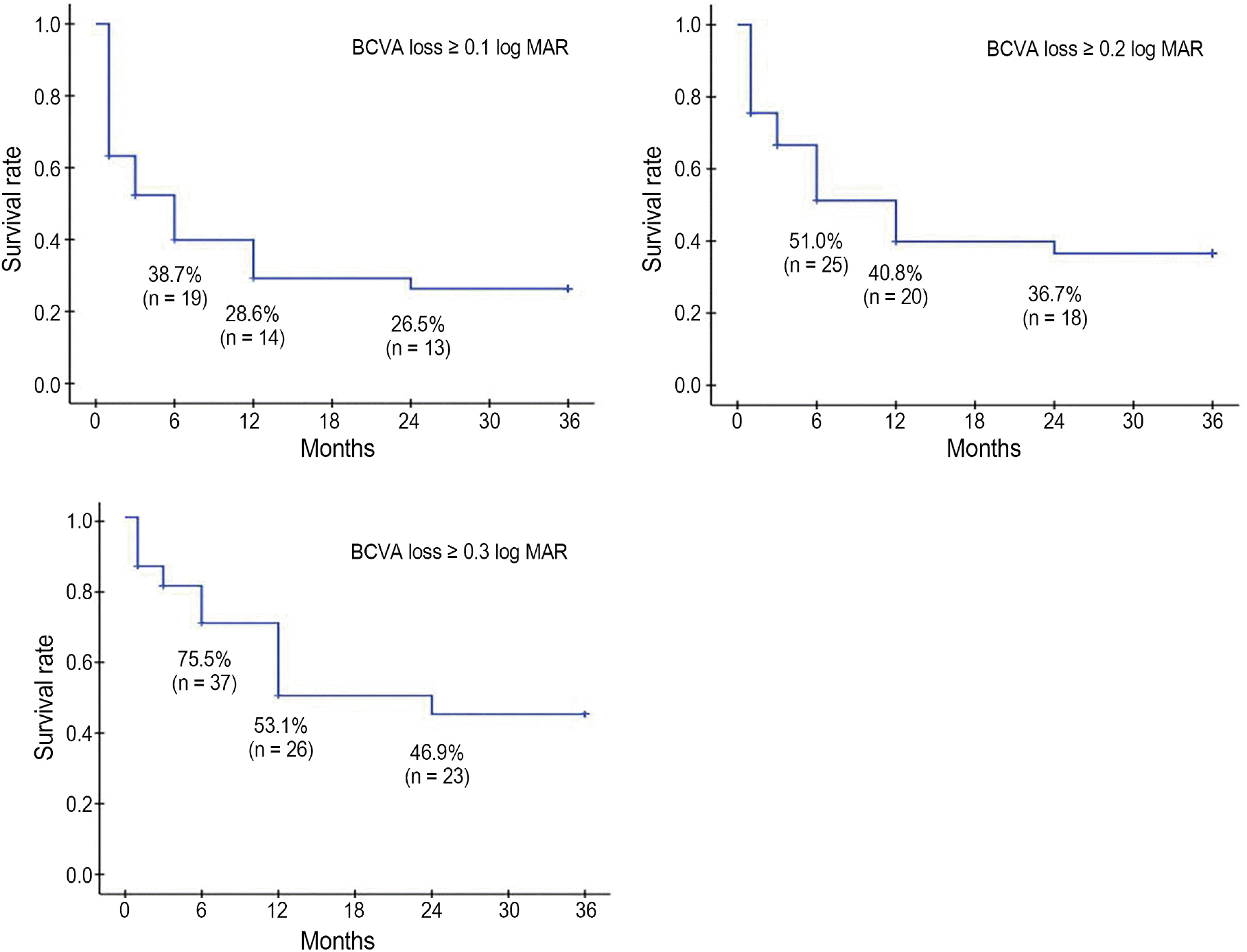1. Beckman H, Fuller TA. Carbon dioxide laser scleral dissection and filtering procedure for glaucoma. Am J Ophthalmol. 1979; 88:73–7.

2. Bietti G. Surgical intervention on the ciliary body; new trends for the relief of glaucoma. J Am Med Assoc. 1950; 142:889–97.
3. Alward WLM. Laser cyclophotocoagulation. Weingeist TA, Sneed SR, editors. Laser surgery in ophthalmology: Practical applica-tions. 1st. East Norwalk, Conn: Appleton and Lange;1992. chap. 14.
4. Pastor SA, Singh K, Lee DA. . Cyclophotocoagulation: a re-port by the American Academy of Ophthalmology. Ophthalmology. 2001; 108:2130–8.

5. Assia EI, Hennis HL, Stewart WC. . A comparison of neo-dymium: yttrium aluminum garnet and diode laser transscleral cy-clophotocoagulation and cyclocryotherapy. Invest Ophthalmol Vis Sci. 1991; 32:2774–8.
6. Brancato R, Leoni G, Trabucchi G. . Histopathology of con-tinuous wave neodymium: yttrium aluminum garnet and diode la-ser contact transscleral lesions in rabbit ciliary body. A com-parative study. Invest Ophthalmol Vis Sci. 1991; 32:1586–92.
7. Spencer AF, Vernon SA. “Cyclodiode”: results of a standard protocol. Br J Ophthalmol. 1999; 83:311–6.

8. Kosoko O, Gaasterland DE, Pollack IP, Enger CL. Long-term out-come of initial ciliary ablation with contact diode laser transscleral cyclophotocoagulation for severe glaucoma. The Diode Laser Ciliary Ablation Study Group. Ophthalmology. 1996; 103:1294–302.
9. Francis BA, Kwon J, Fellman R. . Endoscopic ophthalmic sur-gery of the anterior segment. Surv Ophthalmol. 2014; 59:217–31.

10. Panarelli JF, Banitt MR, Sidoti PA. Transscleral diode laser cyclo-photocoagulation after baerveldt glaucoma implant surgery. J Glaucoma. 2014; 23:405–9.

11. Ishida K. Update on results and complications of cyclopho-tocoagulation. Curr Opin Ophthalmol. 2013; 24:102–10.

12. Egbert PR, Fiadoyor S, Budenz DL. . Diode laser transscleral cyclophotocoagulation as a primary surgical treatment for primary open-angle glaucoma. Arch Ophthalmol. 2001; 119:345–50.

13. Wilensky JT, Kammer J. Long-term visual outcome of transscleral laser cyclotherapy in eyes with ambulatory vision. Ophthalmology. 2004; 111:1389–92.

14. Ansari E, Gandhewar J. Long-term efficacy and visual acuity fol-lowing transscleral diode laser photocoagulation in cases of re-fractory and non-refractory glaucoma. Eye (Lond). 2007; 21:936–40.

15. Bloom PA, Tsai JC, Sharma K. . “Cyclodiode”. Trans-scleral diode laser cyclophotocoagulation in the treatment of advanced re-fractory glaucoma. Ophthalmology. 1997; 104:1508–19. discussion 1519-20.
16. Bloom PA, Clement CI, King A. . A comparison between tube surgery, ND:YAG laser and diode laser cyclophotocoagulation in the management of refractory glaucoma. Biomed Res Int 2013;. 2013; 371951.

17. Gupta V, Agarwal HC. Contact trans-scleral diode laser cyclo-photocoagulation treatment for refractory glaucomas in the Indian population. Indian J Ophthalmol. 2000; 48:295–300.
18. Han SK, Park KH. Long-term results of diode laser trans-scleral cyclophotocoagulation in neovascular glaucoma. J Korean Ophthalmol Soc. 1999; 40:523–31.
19. Moon IA, Youn JW. The effect of transscleral diode laser cyclo-photocoagulation in refractory glaucoma. J Korean Ophthalmol Soc. 1999; 40:2252–8.
20. Schuman JS, Puliafito CA, Allingham RR. . Contact trans-scleral continuous wave neodymium:YAG laser cyclophotocoa-gulation. Ophthalmology. 1990; 97:571–80.

21. Schuman JS, Bellows AR, Shingleton BJ. . Contact trans-scleral Nd:YAG laser cyclophotocoagulation. Midterm results. Ophthalmology. 1992; 99:1089–94. discussion 1095.
22. Hampton C, Shields MB, Miller KN, Blasini M. Evaluation of a protocol for transscleral neodymium: YAG cyclophotocoagulation in one hundred patients. Ophthalmology. 1990; 97:910–7.
23. Brindley G, Shields MB. Value and limitations of cyclocryotherapy. Graefes Arch Clin Exp Ophthalmol. 1986; 224:545–8.

24. Dickens CJ, Nguyen N, Mora JS. . Long-term results of non-contact transscleral neodymium:YAG cyclophotocoagulation. Ophthalmology. 1995; 102:1777–81.
25. Eid TE, Katz LJ, Spaeth GL, Augsburger JJ. Tube-shunt surgery versus neodymium:YAG cyclophotocoagulation in the management of neovascular glaucoma. Ophthalmology. 1997; 104:1692–700.

26. Sood S, Beck AD. Cyclophotocoagulation versus sequential tube shunt as a secondary intervention following primary tube shunt failure in pediatric glaucoma. J AAPOS. 2009; 13:379–83.

27. Yildirim N, Yalvac IS, Sahin A. . A comparative study between diode laser cyclophotocoagulation and the Ahmed glaucoma valve implant in neovascular glaucoma: a long-term follow-up. J Glaucoma. 2009; 18:192–6.
28. Ramli N, Htoon HM, Ho CL. . Risk factors for hypotony after transscleral diode cyclophotocoagulation. J Glaucoma. 2012; 21:169–73.

29. Noureddin BN, Zein W, Haddad C. . Diode laser transcleral cy-clophotocoagulation for refractory glaucoma: a 1 year follow-up of patients treated using an aggressive protocol. Eye (Lond). 2006; 20:329–35.

30. Murphy CC, Burnett CA, Spry PG. . A two centre study of the dose-response relation for transscleral diode laser cyclophotocoa-gulation in refractory glaucoma. Br J Ophthalmol. 2003; 87:1252–7.

31. Iliev ME, Gerber S. Long-term outcome of trans-scleral diode laser cyclophotocoagulation in refractory glaucoma. Br J Ophthalmol. 2007; 91:1631–5.

32. Nabili S, Kirkness CM. Trans-scleral diode laser cyclophoto- co-agulation in the treatment of diabetic neovascular glaucoma. Eye (Lond). 2004; 18:352–6.
33. Rotchford AP, Jayasawal R, Madhusudhan S. . Transscleral di-ode laser cycloablation in patients with good vision. Br J Ophthal-mol. 2010; 94:1180–3.

34. Ghosh S, Manvikar S, Ray-Chaudhuri N, Birch M. Efficacy of transscleral diode laser cyclophotocoagulation in patients with good visual acuity. Eur J Ophthalmol. 2014; 24:375–81.






 PDF
PDF ePub
ePub Citation
Citation Print
Print


 XML Download
XML Download